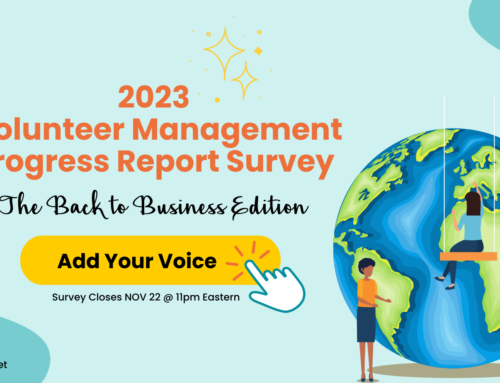How Your Mindset Impacts Your Volunteer Leadership Work
Your mindset is THE most important skill you can master in volunteer leadership work.
Not completely sold? Stay with me for a minute!
Consider how you approach planning your volunteer program strategy. Do you see a chain-link fence, or a wide-open field, full of possibilities?
In other words, do you focus on scarcity and lack, or do you see endless abundance and the potential for success?
So, do you believe there are plenty of people out there ready to help your organization thrive? Or, do you believe that volunteer engagement is, and will continue to be, an uphill battle?
How you think about the future matters. In fact, how you think can have a concrete impact on your future success.
Yes, that’s right. You can become your own self-fulfilling prophecy, to either your advantage or disadvantage.
Don’t believe me yet?
Read on to learn how your mindset plays more of a role in how you lead your volunteers more than you imagine.
Thought Patterns Matter!
Let’s start with the basics.
Did you know that the average person has 12,000 to 60,000 thoughts per day? A 2005 study shows that not only is this true, but that of those thoughts, 80% are negative. And if that’s not mind-boggling enough, 95% of them are the same as the thoughts from the day before.
Yep, left to their own devices, our brains stay stuck on endless loops of negative thought patterns, day in day out.
What’s more, another study found that of those thoughts, 97% of them were baseless worries, causing unnecessary stress, tension, and anxiety.
As busy nonprofit leaders, responsible for leveraging community talent at our organizations, we can influence our outcomes, simply by interrupting these thought patterns.
But we need to be ready to level up how we manage our inner selves. We must proactively correct the impulses that work against us, including how our brains work.
How can we overcome the obstacle of our thought patterns? It CAN be done!
Think of your thoughts as another habit you have, like brushing your teeth or combing your hair. Your thought patterns are formed the same way any other habit is formed: by practicing (or abstaining from) them regularly.
In addition, as you change your own thought patterns, you also have the potential of influencing those around you. So, doing the work is worth the effort.
Changing your thought pattern is no easy feat, but here are a few suggestions to start making waves:
- Meditate: Simply sit still and watch your mind at work. Instead of being drawn into the story line, simply name your thoughts – worrying, planning, etc. After a few sits, you’ll begin to see patterns in your thinking and you can then ask yourself, “Do these thoughts serve me?”
- Keep a journal: There is no way you can write down every single thought you have throughout the day, but if you track the most prominent negative and positive thoughts, you’ll have an idea of where to start.
- Use mantras: After tracking your thoughts you’ll be able to come up with alternatives to combat the negativity. Write these mantras down and recite them whenever you find yourself ruminating in negative thoughts.
- Consider your triggers: People, situations, and circumstances have an impact on your thoughts. When you know what triggers your negative thought patterns, you can plan on times when you need to be more mindful of your need for positive thinking.
When you practice more positive thinking, it has a ripple effect on your other brain waves. Much like when you toss a rock into a calm pond.
In addition, all thoughts about the future are illusions. The future is not reality until it happens. So, while we are often confident about a result, we are more often poor predictors (and, as mentioned earlier we tend toward the negative).
In the end, our thought patterns tell us what we can’t do, what we can’t achieve, what we can’t be.
It’s not that these thoughts predict the future. It’s that a negative thought (the reflects a limiting belief about the future) influences how we act (or decide not to act), thus creating the future consequence and result.
The same could be said of a more affirming thought. It can spark a certain action that, in turn, generates a result.
This is why, out of all the volunteer leadership work you might focus on, you’ll want to start here.
By simply thinking, you can bring about better results.
How Limiting Mindsets Show Up in Your Volunteer Program
The following are some limiting beliefs of mindsets that often crop up around volunteer engagement.
Note how they focus on scarcity and lack rather than abundance.
They deserve to be examined and challenged by leaders of volunteers who are looking to grow and sustain their volunteer programs.
The more you question whether these are a) based in reality and b) serve your organization, the faster you can begin to replace them with enabling beliefs that are precursors to better outcomes.
Have you seen any of these expressed in words or actions at your nonprofit?
Fixed Mindset #1 – Volunteer leadership works comes naturally and supervisory talent is innate; we’re either born with it or we’re not.
Despite evidence to the contrary (research shows that only about 30% of leadership is innate), organizations insist on the “superhero model” of staff and volunteer leadership work. We often hear, “If I could only find the ‘right’ volunteers, everything would fall into place.”
In reality, training and leadership development can have real impact for both volunteers and staff.
Overcome this mindset by finding the right tools and mentors and making a consistent effort to learn to lead.
Fixed Mindset #2 – Volunteer Services falls at the bottom of the organizational leadership chart. Because of this, I am powerless to make progress at my nonprofit.
We know this is a recurring challenge for leaders of volunteers. Executives (some, not all!) at the top simply don’t see how valuable volunteers are to the organization.
In turn, some leaders of volunteers have given up hope of getting traction with any new or innovative strategy. They believe, “We simply don’t have enough resources and won’t get any in the future, so I might as well not try.”
Unfortunately, this frustration and lack of support keeps volunteer services staff from doing the tough, gritty work needed to bring about and sustain growth and success. But in order to take risks, you must believe all things are possible.
Want to feel more inspired and supported in your work? Have the courage to set meaningful goals and believe that with perseverance, you can create pathways to success from where you are. Here’s one of my favorite videos on believing in what’s possible. Just note, it’s long and there’s a religious undertone to it, but the message is still very impactful regardless of your religious beliefs!
Fixed Mindset #3 – No one understands the limitless potential of what volunteer teams can achieve except me.
Leaders of volunteers all know volunteers are important; however, proving that value to other nonprofit staff is challenging at times.
How can you show your colleagues what volunteers can help them achieve? Set meetings with every department and begin conversations about pain points and shared goals. Then, consider their top paint points and inform them how strategic volunteer involvement can help address them.
An enabling mindset believes that allies are everywhere. You just need to know where to look. You may be pleasantly surprised that many of your colleagues are, or have been, volunteers themselves and can empathize with what you are trying to achieve.
Fixed Mindset #4 – Because nonprofit staff believe in the mission, they need very little support to be successful.
We also hear a variation of this when it comes to community supporters – Because volunteers are “free,” both they (and the volunteer coordinator) need very little support or infrastructure to achieve results.
Want to challenge this assumption? Consider this situation: what if, tomorrow, your entire volunteer corps walked out? If you rely on volunteers to meet your mission – and you’re concerned about volunteer turnover — you can’t afford to ignore their needs. Naturally, the same goes for paid staff.
If your volunteers expand across your agency and are vital to your success, they must be adequately acknowledged and supported for their important work.
Fixed Mindset #5 – Because we lead in a nonprofit setting, we should make extreme personal sacrifices and be content to scrape by.
This limiting belief also often comes with the addition, “I should expect others (including those outside my organization) to do so, as well.”A scarcity frame of mind can do nothing but keep nonprofits stuck. In addition, asking staff to make extreme sacrifices only compounds the rampant burnout in the profession.
Instead, replace this limiting belief with a self-care mantra. I deserve and have the right to my own time for self-care. It is in my organization’s best interest that my well-being is supported. The more energized I feel, the more I can give when I am on the job.
Once you start addressing these common limiting beliefs, you can begin to make progress in demonstrating the volunteer leadership work that will keep people coming back and contributing productively to your good cause.
Master Your Mindset, Master Your Volunteer Leadership Work
Take note of how the above mindsets show up in your nonprofit and volunteer leadership work.
When you start to notice your limiting beliefs taking over, re-frame them by replacing them with enabling beliefs. As mentioned earlier in this blog, consider writing a mantra or affirmation that inspires you to keep reaching and growing.
Below are some examples of enabling beliefs, organized around four themes, and some mantras you can add to some of the suggestions above to repeat. In no time, you’ll begin to overcome negative thought patterns in yourself and others.
Theme #1: Probability
Everyone is prone to being blindsided by the unknown. Things will either go as planned in your volunteer program, or the unexpected will happen. If you have a limiting mindset, you won’t be able to work through those unexpected challenges.
Here are two enabling mantras you can repeat to help you overcome the unknown:
-
- If I always do what I’ve always done, I’ll always get what I’ve always had.
- There’s a chance that this will work, so I might as well give it a try.
Theme #2: Ability
When you believe you aren’t able to do something, or ask for something, or receive something, you are likely to not even try for it. However, if you believe you can do something, that is half the battle!
Repeat these mantras to start building your confidence in your ability to succeed:
-
- I can do this; I just need to try.
- There are no mistakes or failures, only lessons to learn.
Theme #3: Existence
By thinking things into existence, you are allowing yourself to believe them to be true. So, even if you are faced with a challenging task or project that you’ve never experienced before, you can use an “I am…” statement to reflect who you want to be seen as in certain situations.
Here are some mantras to start re-constructing your self-view:
-
- I am intelligent and I can learn how to do this.
- I am the change.
Theme #4: Respect
We live in a world where we constantly feel judged, harshly, by our family, friends, colleagues, essentially anyone we come into contact with. As a result, we might act defensively and avoid meaningful interactions.
Adopt these mantras to help you realize that you are a valued and respected leader:
-
- My needs are important and so the needs of everyone else.
- Respect comes from within, not without.
As with any other habit, repetition is king in establishing new thought patterns.
To boost your commitment to cultivating a more positive, enabling mindset, start to look for evidence that the mantra you are repeating to yourself is true. Once you start looking, you’ll be surprised at how much proof you find! Keep those in mind every time.
To boost repetitive thoughts, once you’ve decided on an enabling belief, look for evidence that your new belief is true. You will likely find plenty of clues and proof and as you do, you’ll further cement your new positive thought patterns.
And remember, the more you repeat enabling beliefs in your mind, the better chance they will have to stick.
FREE Download: Miracle Mindset Worksheet
According to Sources of Insight, “Mind-sets are those collection of beliefs and thoughts that make up the mental attitude, inclination, habit or disposition that predetermines a person’s interpretations and responses to events, circumstances and situations.”
Translation: History is not destiny.
Mindsets dictate your actions. BUT, if you recognize them, you can change them.
- Self-reflect on your current thoughts and patterns
- Change your limiting beliefs into enabling beliefs
- Create and implement positive mantras
- Create a game plan for the future








